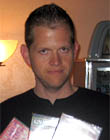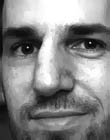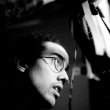|
|
This topic comprises 2 pages: 1 2
|
|
Author
|
Topic: Scanner resolution?
|
|
|
|
|
Bobby Henderson
"Ask me about Trajan."

Posts: 10973
From: Lawton, OK, USA
Registered: Apr 2001
|
 posted 11-26-2004 11:01 PM
posted 11-26-2004 11:01 PM




Epson has affordable flatbed scanner models capable of up to 4800 X 9600 dpi/ppi optical resolution. That's usually more than enough rez for a lot of tasks.
Newspapers typically don't need photo artwork any better than 200 dpi. Even for most color magazines, which typically feature line screens or halftone frequencies between 133 and 200lpi, 300dpi would be good enough. Generally you want to scan around 1.5X to 2X the amount of your output screen.
If you're scanning in line art, graphical work, etc. then the higher resolutions can come in more handy. For instance, I'll get the task sometimes of having to reproduce some tiny logo on some shitty business card. The larger and more "focused" I can get the thing into the computer makes the reproduction process easier.
High resolutions are also very necessary when scanning transparancies, like film strips, slides, etc. Most flatbed scanners have a disadvantage from the glass in the scanning bed. Sometimes you can get a "Newton ring" thrown into your aquired image. That artifact looks a little like the halos some lens elements will transfer into a photograph.
For screen based work, such as web pages, the "dpi" or "ppi" thing doesn't mean shit. You just work in absolute pixel numbers.
Resolution alone isn't everything. You also need to look at things like dynamic range capability. Scanners that aquire only reflective art (such as paper, photo prints, etc.) will not capture the amount of color fidelity available in transparent art, such as film negatives, slides, etc. Generally, dedicated slide scanners will offer better color fidelity than flatbed scanners when it comes to film-based scans.
Of course, the kings of the hill on scan quality are still those very expensive drum scanners. They don't use CCDs and cold cathode lamps. Instead they use photomultiplier tubes. Often they can scan in higher resolutions and capture much richer more true color than most flatbed units. In motion picture CGI work, most film plates are scanned into computer systems using very carefully calibrated drum scanners.
| IP: Logged
|
|
|
|
|
|
|
|
|
|
|
|
John Pytlak
Film God

Posts: 9987
From: Rochester, NY 14650-1922
Registered: Jan 2000
|
 posted 11-29-2004 10:14 AM
posted 11-29-2004 10:14 AM





Kodak designed and builds the 2K and 4K film scanners used in the Thomson Spirit datacines:
http://www.kodak.com/US/en/motion/products/v2/sehlin.shtml
quote:
...we showed a new high-speed scanner, along with Thomson. It's a 2K/4K scanner that is about five times faster than the next fastest scanner, which also happens to use our technology: the Thomson Spirit DataCine, a tool that has revolutionized the use of digital imaging techniques. This new scanner captures uncompressed image data and does it at rates that were unheard of just a few years ago. We believe this will help drive the move toward digital intermediate technology.
Kodak CineSite also has information on the scanners it uses:
http://www.cinesite.com/?1231&0&1269
quote:
NORTHLIGHT SCANNER
Cinesite recently installed Northlight film scanners at both the Los Angeles and London facilities. This new generation of scanners, developed by FilmLight in London, utilizes an 8K tri-linear CCD array manufactured by Kodak to convert film at either three- or four-perforations of height per frame to digital files. Cinesite can now scan 35 mm color negative film at speeds around four times faster than the previous generation of machines making it more practical to convert nuances in colors, contrast and other details captured on the original negative to digital files.
KODAK LIGHTNING 35MM SCANNER
The Lightning film scanner, the finest system available for digital imaging, is the cornerstone of Cinesite's scanning capability. Featuring CCD sensor technology with three linear photosite arrays of 4,096 pixels each, the scanner handles the most common 35mm aspect ratios of Full Aperture (1024,2048 & 4096 lines resolution), Cinemascope and Academy (914, 1828 & 3656), and Vista Vision format (6144).
At 4000 lines, the Lightning scanner captures 38.9mb of data per frame from the standard 35mm format, Cinemascope captures 45.5mb, Full Aperture 51mb and Vista Vision exactly 100mb. The 4000 line resolution provides more than sufficient headroom for the level of image manipulation upon which our customers stake their reputations.
Each CCD array has a custom filter tuned to the dye densities of Eastman Color film, and is capable of capturing the full dynamic range of the images being scanned.
GENESIS PLUS 65MM SCANNER
Cinesite is excited about the tremendous growth happening in the large format, special venue industry. The Kodak Genesis Plus scanner brings the same dynamic and robust digital tools to the 65mm wide-screen filmmaker that are available with the 35mm Lightning scanner. The Genesis Plus handles 5, 8, and 15 perf formats.
Kodak makes a wide variety of very high resolution CCD sensors (up to 22 megapixels) for use in digital imaging:
http://www.kodak.com/global/en/digital/ccd/sensorsMain.jhtml
Kodak Linear Array sensors used in color scanners have up to 14,400 pixels across their length for red, green and blue:
http://www.kodak.com/global/en/digital/ccd/products/linear/linearMain.jhtml
quote:
Linear Image Sensors Family Overview
Features
Family of devices (up to 14,400 pixels; color or monochrome)
High dynamic range (up to 16 bits)
Pinned photodiodes for low lag and dark current
Channel independent electronic exposure control
Single output per color, including multi-readout register architectures
High data rates (up to 120 Mhz)
Kodak monochrome and color linear imagers are available for use in flatbed scanners, high speed document scanners and copiers, machine vision cameras, studio photography, and satellite imaging.
| IP: Logged
|
|
|
|
|
|
|
|
Mike Heenan
Phenomenal Film Handler

Posts: 1896
From: Scottsdale, AZ, USA
Registered: Mar 2000
|
 posted 12-08-2004 08:00 PM
posted 12-08-2004 08:00 PM




Thanks for all the tips guys, I decided on a HP scanner all in one unit (printer, scanner and copier) that does 600x2400 scans, is that pretty good for home use (scanning papers, etc, photos for color restoration, and whatnot), the 1315 model I believe. I dont intend on doing any high end graphic work so I dont need anything that expensive. Do you think this would be a good enough deal at $100, or should I get one of those higher optical rez scanners 2400x4800 at about $100 more or so?
| IP: Logged
|
|
|
|
|
|
|
|
All times are Central (GMT -6:00)
|
This topic comprises 2 pages: 1 2
|
Powered by Infopop Corporation
UBB.classicTM
6.3.1.2
The Film-Tech Forums are designed for various members related to the cinema industry to express their opinions, viewpoints and testimonials on various products, services and events based upon speculation, personal knowledge and factual information through use, therefore all views represented here allow no liability upon the publishers of this web site and the owners of said views assume no liability for any ill will resulting from these postings. The posts made here are for educational as well as entertainment purposes and as such anyone viewing this portion of the website must accept these views as statements of the author of that opinion
and agrees to release the authors from any and all liability.
|

 Home
Home
 Products
Products
 Store
Store
 Forum
Forum
 Warehouse
Warehouse
 Contact Us
Contact Us




 Printer-friendly view of this topic
Printer-friendly view of this topic









![[Razz]](tongue.gif)
![[Wink]](wink.gif)

![[Confused]](confused.gif)

![[Smile]](smile.gif)
![[Cool]](cool.gif)





